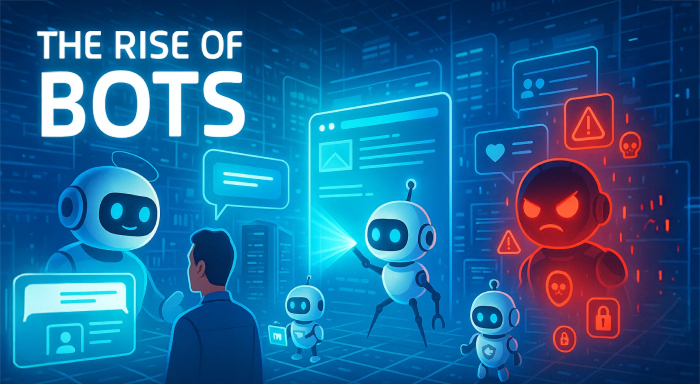In today’s connected world, bots can be seen everywhere, from guiding potential customers around an e-commerce site to providing customer support during difficult times. With just one click, bots can perform complex tasks in a single operation without any human intervention. But before diving deeper into how bots work, let’s first understand what bots are.
What are Bots?
Bots is a shortened term for robots. They are software programs that perform automated repetitive tasks, freeing humans for other critical tasks and decision making. They can also mimic humans. Bots are built for different purposes depending on their design, goal, and the algorithm.
Bots help companies in many ways, enhancing their sales and feedback system. They can also work behind the scenes. In gaming, for example, Pokémon raid bots help players find rare Pokémon during special game events, making competitive hunting easier and more efficient. However, just like every coin has two sides, bots can also be misused. Dangerous bots are programmed for harmful purposes, often used by hackers and spammers to carry out malicious activities around the internet in different ways, like spamming, scraping data, etc.
They can run
- Continuously (Fortnite bots)
- On a schedule (Buffer)
- Through a trigger (Home automation bots)
Types of Bots
There are different bots, and we will discuss both ethical and unethical bots to understand the difference between how some help us and how some can destroy us.
- Search Engine Crawlers: Also known as spiders, are used to scan websites, which helps search engines like Google to rank the sites.
- Chatbots: They are designed to assist and communicate with users 24/7 through human-like conversations. Like My AI, a Snapchat bot.
- Shopping Bots: These compare product prices across different sites, look for discounts, and offer suggestions to customers.
- Download bot: These can be used for both legitimate and malicious purposes. For example, they can increase download stats for a product, but pirated sites also use them unethically.
- Social Media Bots: They are automated programs used to behave like users through likes, comments, and fake followers. Their ethical impact depends on their usage.
- Transaction Bots: These AI agents help with financial transactions. On e-commerce sites, they often verify credit card details and ensure the transaction is safe.
- Spambot: Malicious bots are used to spam platforms with fake users or data. For example, blooket bots fill the game with fake users and mess things up for other players.
- Botnets: Also known as a bot herd. These are groups of infected, internet-connected devices used for cyberattacks, scams, and other illegal activity.
How do Bots Work
Bots are programmed using code, often written in languages like Python, C++, or JavaScript. They follow a set of instructions to perform specific tasks, usually time-consuming and repetitive ones. They are generally triggered by specific actions, keywords, or scheduled events. Most of them execute their actions through scripts or APIs (Application Programming Interfaces). Once triggered, they follow the instructions in their algorithm and carry out the task they were built for.
Benefits of Bots
- Customer Satisfaction: These tools increase customer satisfaction through guiding them and immediately responding to their complaints.
- 24/7 Work: They don’t need rest; they can operate round the clock, helping businesses always stay active.
- Repetitive tasks: Bots take care of repetitive work so humans can focus on more important tasks.
- Speed: Bots are much faster than humans. They’re ideal for retrieving data and handling large amounts of information.
- Human-like conversation: This programmed software can mimic human conversation, making users feel like they're talking to a real person.
Limitations of Bots
- Privacy issues: People often share personal information with chatbots. This data can be misused or leaked during a cyberattack.
- Interference: This malware software can be used to spam, cheat, or crash systems. Example: Kahoot bots can flood a quiz with hundreds of fake players, making the game unusable for real players and interfering with the classroom.
- Server Overload: Large malicious software like spamming bots can overload the servers, causing the website or the app to crash.
- Reduced User Experience: On social media, when bots comment like humans, it reduces authenticity and trust. Example: Fake Instagram likes and comments used by businesses to appear popular.
Save Yourself from Malicious Bots
With bad bots all around us, it's necessary for us, especially businesses, to save their sensitive information from hackers. Here are some habits that can help secure your network:
- Install Antivirus Software: Antivirus programs help detect and remove harmful files or bots. Keep them updated. Popular ones include Avira, Norton, and McAfee.
- Bot Manage: If you own a site or an app, it's a good idea to secure your entry site through CAPTCHA protection to detect if any malicious software tries to enter your system.
- Password: Use strong, unique passwords (across all platforms) and update them regularly. Enable two-factor authentication for extra security.
- Trusted links: Make sure the links that you click are of a trusted brand or person. Even if you find a trusted person sending you a suspicious link, don’t click before checking.
- Stranger Danger: Never accept friend requests from strangers on social media and avoid talking to them. Many bots pretend to be a real person and trick people into clicking a malicious link. Remember the rule from childhood, “stranger danger.”
Conclusion
Bots are powerful tools that have become deeply integrated into our online world. From the Medical Revolution through nano bots to helping businesses grow, they offer countless benefits. However, we must stay alert, as the same technology can be used with bad intentions. By understanding how to protect ourselves, we can enjoy the advantages of bots while staying safe in the digital world.



